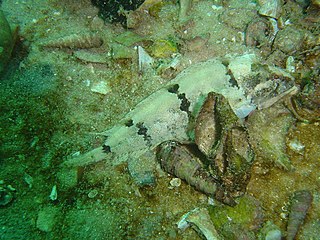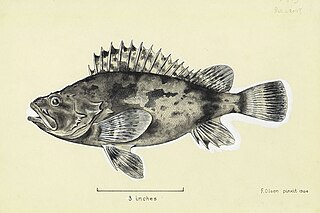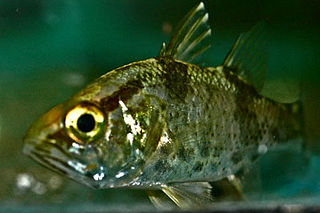
Cephalopholis fulva, the coney or the butterfish, is a species of marine ray-finned fish, a grouper from the subfamily Epinephelinae which is in the family Serranidae which also includes the anthias and sea basses. It is found in the western Atlantic. It is associated with reefs and is a quarry species for commercial and recreational fisheries. It can be found in the aquarium trade.
Malapterurus beninensis is a species of electric catfish native to the African nations of Angola, Benin, Cameroon, the Democratic Republic of the Congo, the Republic of the Congo, Equatorial Guinea, Gabon, Ghana, Nigeria and Togo. This species grows to a length of 22 cm (9 in) SL. Its habitat is lowland marshes, rivers, and lakes.
The Triton epaulette shark is a species of bamboo shark in the genus Hemiscyllium, that is composed of nine morphologically similar, yet distinct sharks that are geographically restricted to New Guinea and northern Australia. Hemiscylliidae are small nocturnal sharks aptly named "walking sharks" who exhibit a "crawling" movement while foraging on the ocean floor for fish and benthic invertebrates.
Callionymus belcheri, Belcher's dragonet or the flathead dragonet, is a species of dragonet native to the Pacific Ocean waters off of Australia and Papua New Guinea where it occurs at depths of from 18 to 36 metres.
The painted swellshark is a little-known species of catshark, belonging to the family Scyliorhinidae, found in eastern Indonesia. This species reaches a maximum known length of 72 cm (28 in), and has a thick body with a short, broad and flattened head. It is dark gray with a variegated pattern of irregular darker and lighter blotches above, and lighter below with gray blotches and speckling on the snout. Like other swellsharks, it can inflate itself as a defensive measure.

The longfin grouper, also known as the longfin rockcod, bar-breasted rock-cod, Gilbert's rock-cod, honeycomb rockcod, spotted groper or wirenet cod, is a species of marine ray-finned fish, a grouper from the subfamily Epinephelinae which is part of the family Serranidae, which also includes the anthias and sea basses. It is found in the Western Pacific Ocean.

Clinus agilis, the agile klipfish, is a species of clinid found in subtropical waters of the Atlantic Ocean from Namibia to South Africa where it is commonly found in estuaries and tide pools. This species can reach a maximum length of 10 centimetres (3.9 in).
Clinus brevicristatus, the Cape klipfish, is a species of clinid that occurs in subtropical waters of the Atlantic Ocean around South Africa where it prefers habitats with plentiful growth of seaweed. This species can reach a maximum length of 12 centimetres (4.7 in) TL.

The bullrout, also commonly called freshwater stonefish or kroki, is a pale yellowish to dark-brown coloured fish that lives in tidal estuaries and slow-flowing streams in eastern Australia, from Southern New South Wales to northern Queensland, Australia. It has on a very infrequent occurrence been caught at sea. Its spines are venomous. It is the only member of the genus Notesthes.
The West African bichir or retropinnis bichir, is a freshwater fish in the family Polypteridae, is found in the central Congo River basin and Ogooué River in Africa. It is a long, slender fish that grows to a maximum length of about 34 cm (13 in).
The visitor, also known as the sandpaper velvetfish,is a species of marine ray-finned fish, a velvetfish belonging to the family Aploactinidae. It is the only member of the monotypic genus Adventor. This species is found the Pacific Ocean waters along the coasts of Papua New Guinea and Australia.

Glossamia is a genus of freshwater fish in the family Apogonidae. The majority of the species are endemic to New Guinea, but G. aprion is also found in Australia.

Epinephelus sexfasciatus, the sixbar grouper, sixbar rockcod or six-banded rockcod, is a species of marine ray-finned fish, a grouper from the subfamily Epinephelinae which is part of the family Serranidae, which also includes the anthias and sea basses. It is found in the Indo-Pacific region.

Lutjanus rivulatus, the blubberlip snapper, Maori snapper, blue-spotted seaperch, Maori bream, Maori seaperch, multi-coloured snapper, scribbled snapper, speckled snapper or yellowfin snapper, is a species of marine ray-finned fish, a snapper belonging to the family Lutjanidae. It is native to the Indian Ocean and into the Pacific Ocean.

Pomadasys kaakan, the javelin grunter or barred javelin is a species of marine ray-finned fish, a grunt belonging to the family Haemulidae. It is native to the Indian and Pacific Oceans, from Africa to Australia.

Pelates quadrilineatus, also known as the trumpeter perch or fourlined terapon, is a species of ray-finned fish in the family Terapontidae, the grunters. It occurs in the western Indo-Pacific region, and also in the eastern Mediterranean Sea, having arrived there by passing through the Suez Canal.

The spotbanded scat,(Selenotoca multifasciata), also known as the striped scat, banded scat, barred scat, butterfish, John Dory, Johnny Dory, old maid, Southern butter-fish or striped butterfish, is a species of ray-finned fish, belonging to the family Scatophagidae, the scats. They are found in the eastern Indian Ocean and southwestern Pacific Ocean.

Gobiomorphus coxii, or Cox's gudgeon, is a species of sleeper goby in the family Eleotridae which is native to the upland rivers of south eastern Australia.

Aplodactylus westralis, the western sea carp or cockatoo morwong, is a species of marine ray finned fish, one of the marblefishes belonging to the family Aplodactylidae. It is found in the eastern Indian Ocean off the coast of Western Australia.

Platycephalus bassensis the Southern sand flathead, Bass flathead, bay flathead, common flathead, sand flathead, sandy, sandy flathead, slimy flathead or yanks, is a species of marine ray-finned fish belonging to the family Platycephalidae, the flatheads. It is endemic to Australia.













